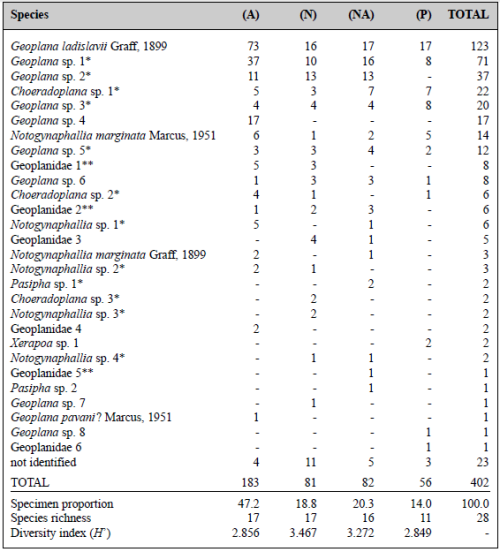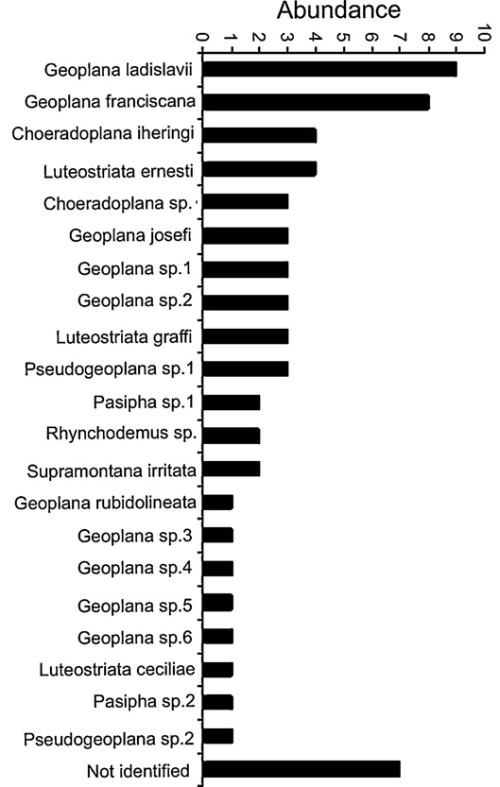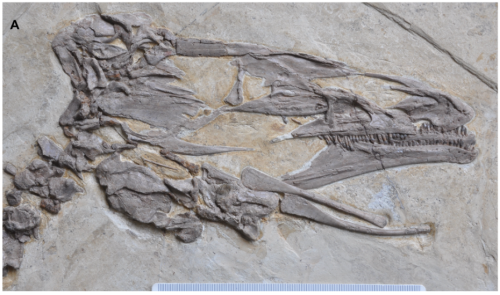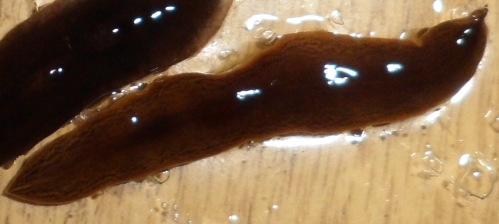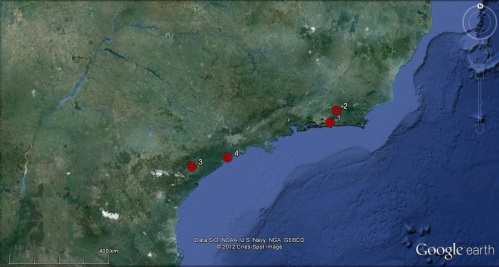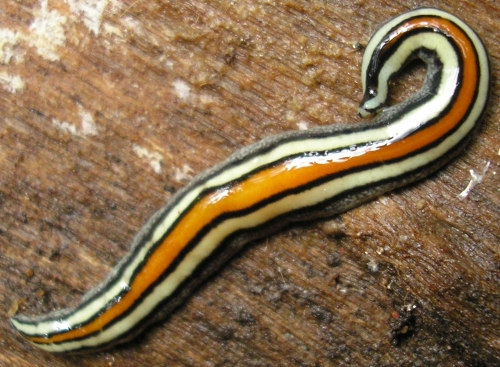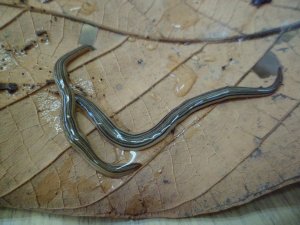by Piter Kehoma Boll
 Oh, ye olde times…
Oh, ye olde times…
The 18th and 19th centuries were well marked by great worldwide expeditions by naturalists aboard ships travelling all around the world. Charles Darwin is certainly the most famous of them, but he was not the only one.
One of those naturalists was Karl Ludwig Schmarda, born in 1819. He studied in Vienna and was later a professor at the University of Graz, Austria. From 1853 to 1857, he travelled around the world investigating several locations and collecting primarily invertebrates. After his return, he published a work entitled Neue wirbellose Thiere beobachtet und gesammelt auf einer Reise um die Erde 1853 bis 1857 (New invertebrate animals observed and sampled on a travel around the Earth, 1853 to 1857).
Among the countless animals that he described, there was a worm which he called Prostheceraeus terricola. The description is as it follows:
Prostheceraeus terricola. Schmarda.
Taf. VI. Fig. 69.
Char. : Corpus oblongo-lanceolatum. Dorsum convexum viride. Fascia mediana et margo purpureus. Tentacula subuliformia.
Der Körper ist weniger flach als in andern Planarien, länglich, hinten lanzettförmig zugespitzt, vorne beinahe quer abgeschnitten. Die Fühler sind kurz und pfriemenförmig zugespitzt. Der Rücken ist stark convex, fast grasgrün, mit einer purpurrothen Längslinie nach seinem ganzen Verlaufe. Der Rand nicht wellenförmig, purpurroth gesäumt. Die Hauchfläche ist grünlichgrau. Die Länge 20mm, grösste Breite 5mm. Die Augen sind am innern Rande und der Basis der Fühler. Die Gruppe im Nacken, habe ich nicht beobachtet. Die Mundöffnung ist im vordern Drittel. Die Geschlechtsöffnungen habe ich nicht aufgefunden.
Der Grund meiner unvollständigen Kenntniss dieser Thierform ist der Umstand, dass ich nur ein Exemplar in dem obern Theile des Quindiu-Passes ober der Region der Bergpalmen gefunden hatte, welches ich in Gallego skizzirte, das aber schon zu Grunde gegangen war, als ich es in meiner Abendstation in Tocho einer wiederholten nähern Prüfung unterziehen wollte.
In English:
Oblong-lanceolate body. Green convex dorsum. Median and marginal purple stripes. Awl-like tentacles.
The body is less flat than in other planarians, elongated, behind pointed and lanceolate, front almost transversally cut. The feelers are short and awl-like pointed. The back is strongly convex, almost grass green with a purple line running fully along it. Margin not wave-like and purple-colored. The ventral surface is greenish gray. Length 20mm, largest width 5mm. The eyes are at the inner border and the base of the feelers. The group at the neck I didn’t observed. The mouth opening is in the front third. The sexual opening I did not found.
The reason of my incomplete knowledge of this animal form is due to the circumstance of finding only one specimen in the top part of the Quindiu passage above the region of the mountain palms, which I sketched it in Gallego, since it was already deteriorating, to undergo a revision back at the station in Tocho.
Here you can see the drawing of the animal:

Drawing of Prostheceraeus terricola by Schmarda, 1859
Schmarda put other worms in the same genus, all of them marine. The genus is valid until today for marine species and they are classified as belonging to the Polycladida, those beautiful sea flatworms.
In fact, this animal actually looks kind of similar to a polyclad, but Schmarda found it on the top of the mountains! Quite unusual, and unfortunately he found only one single specimen.

Prostheceraeus giesbrechtii, another species described by Schmarda (1859). Photo by Parent Géry taken from commons.wikimedia.org
Later, in 1862, K. M. Diesing made a revision of turbellarians and defined that, as the creature lived on land, it was certainly something other than a polyclad and changed it to a new genus which he called Leimacopsis (slug-like):
XVIII. LEIMACOPSIS DIESING.
Prostheceraei spec. Schmarda.
Corpus elongato-lanceolatum, supra convexum. Caput corpore continuum antice truncatum, tentaculis duobus genuinis frontalibus. Ocelli numerosi tentaculorum. Os ventrale antrorsum situm, oesophago… Apertura genitalis. . . Terrestres, Americae tropicae.
1. Leimacopsis terricola DIESING.
Corpus elongato-lanceolatum, supra convexum, viride, vitta mediana corpori aequilonga et marginibus haud undulatis purpureis, subtus viridi-cinereum. Tentacula subuliformia, brevia. Ocelli ad marginem internum et ad basim tentaculorum. Os in anteriore corporis tertia parte. Longit. 10′”, latit. 2 1/3 “.
Prostheceraeus terricola Schmarda: Neue wirbell. Th. I. 1. 30. Tab. VI. 69.
Habitaculum. In parte superiore transitus Andium Quindiu, supra regionem Palmarum montanarum (Bergpalmen), specimen unicum (Schmarda).
It’s basically a repetition of Schmarda’s description and based only on it. It looks that no other specimens were found until this time.
Years later, in 1877, H. N. Moseley published a catalogue of all land planarians known at the time. He included Leimacopsis terricola with the following description:
Family. — Leimacopsidæ, Diesing.
Genus Leimacopsis. — Diesing, Revision der Turbellarien, Abtheilung Dendrocoelen, Sitzbt. Akad. Wiss., Wien, 1861, p. 488.
Leimacopsis terricola.—Diesing, 1. c.
Prostheraceus terricola. — Schmarda, ‘Neue Wirbellose Thiere,’ Th. 1, 1—30, Tab. VI, fig. 69.
With a pair of true frontal tentacles beset with numerous eyes. Occurs high up in the Andes at the pass of Quindiu, above the region of mountain palms.
As you can see, it’s again simply a repetition of Schmarda’s description based on that single specimen from 20 years earlier, but from Diesing on, the animal started to be considered a land planarian rather than a polyclad.
Now in 1899, Ludwig von Graff published his great monography about turbellarians and I’m certain that I saw something about Leimacopsis there. Unfortunately I never found a digital copy of it and I don’t have a physical copy easily accessible either, but according to Ogren (1992), it has only a repetition of Schmarda’s account. Graff, however, changed the spelling to Limacopsis, but this is not valid according to the International Code of Zoological Nomenclature.
In 1914, finally a new article, by O. Fuhrmann, was published with information about land planarians from Colombia. He begins commenting that there were only three species known for the country by that time, one of them being Limacopsis [sic] terricola. However, the species was not found again this time…
The years passed and nothing changed. In 1991, Ogren and Kawakatsu, in part of their index to the species of land planarians, comment that several researchers, like E. M. Froehlich and L. H. Hyman, considered Leimacopsis terricola as possibly being a slug.
In 1992, Robert Ogren wrote an excellent revision of this species, which presents all information I have given here and much more. He concluded that the organism is a species inquerenda (needing further investigation) and nomen dubium (doubtful name). It is not possible to assign the animal as either a flatworm or a mollusk, or anything else due to the lack of information. Ogren considered it as “clearly part of the lore of Cryptozoology”.
As we can see, cryptids don’t need to be big animals like dinosaurs or big feet. Even a small slug-like worm from the Andes may fit.
Leimacopsis terricola is certainly an interesting organism. What was it really? Was it real? Maybe an extensive research in the area would reveal something… or not. Let’s wait and hope… Or perhaps… what about going to an adventure in Colombia’s Andean region in search of the mysterious creature?
– – –
References:
Diesing, K. M. 1862. Revision der Turbellarien. Abtheilung: Dendrocoelen. Keiserlich-Königlichen Hof- und Staatsdruckerei DOI: 10.5962/bhl.title.2108
Fuhrmann, O. 1914. Planaires terrestres de Colombie. In: Fuhrmann & Mayor (eds.) Voyage d’Exploration Scientifique en Colombie. Mémoires de la Société des sciences naturelles de Neuchâtel, 5 (2), 748-792
Moseley, H. 1874. On the Anatomy and Histology of the Land-Planarians of Ceylon, with Some Account of Their Habits, and a Description of Two New Species, and with Notes on the Anatomy of Some European Aquatic Species. Philosophical Transactions of the Royal Society of London, 164, 105-171 DOI: 10.1098/rstl.1874.0005
Ogren, R. E. 1992. The systematic position of the cryptic land organism, Leimacopsis terricola (Schmarda, 1859)(olim Prostheceraeus)(Platyhelminthes). Journal of The Pennsylvania Academy of Science, 66 (3), 128-134
Ogren, R. E. & Kawakatsu, M. 1991. Index to the species of the family Geoplanidae (Turbellaria, Tricladida, Terricola) Part II: Caenoplaninae and Pelmatoplaninae. Bulletin of Fuji Women’s College, 29, 35-58
Schmarda, L. K. 1859. Thiere beobachtet und gesammelt auf einer Reise um die Erde 1853 bis 1857. Lepizig: W. Engelmann. DOI: 10.5962/bhl.title.14426
![]() I have already written on the problems of taxonomy in small and not-so-cute groups in a previous post, where I talked about the fact that several species, after being described, are completely ignored for decades or centuries. Here I will focus on the other extreme: the species yet to be described.
I have already written on the problems of taxonomy in small and not-so-cute groups in a previous post, where I talked about the fact that several species, after being described, are completely ignored for decades or centuries. Here I will focus on the other extreme: the species yet to be described.
